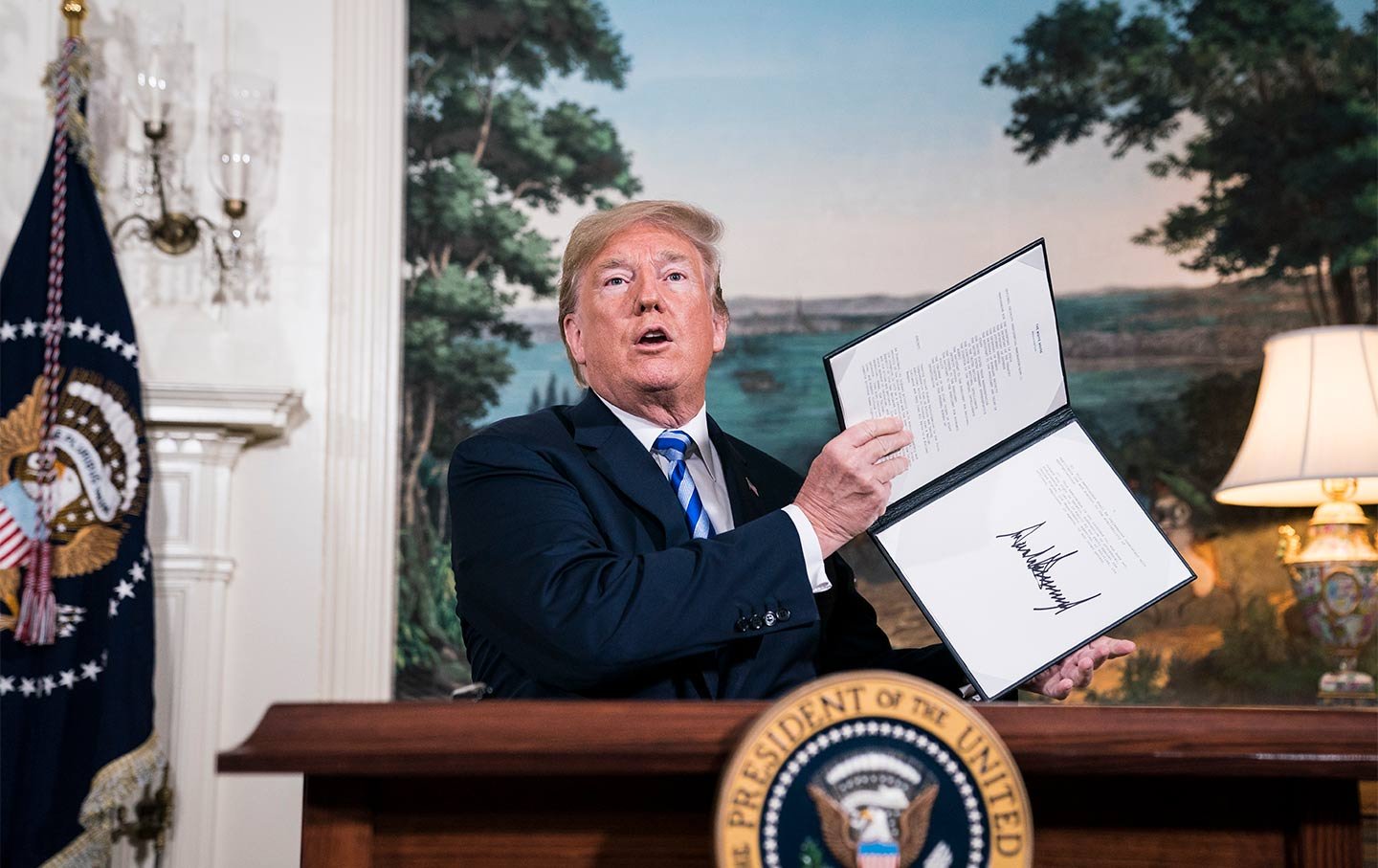What Will a Peace Movement Look Like Under Trump’s Second Presidency? An all-hands-on-deck approach to the coming world of Donald Trump and crew is distinctly in order.
President Donald Trump announces his withdrawal of the United States from the Iran nuclear deal on May 8, 2018.
(Jabin Botsford / The Washington Post, via Getty Images)
This article originally appeared at TomDispatch.com. To stay on top of important articles like these, sign up to receive the latest updates from TomDispatch.com.
When the election results came in on November 5, I felt a pain in the pit of my stomach, similar to what I experienced when Ronald Reagan rode to power in 1980, or with George W. Bush’s tainted victory over Al Gore in 2000. After some grieving, the first question that came to my mind was: What will a Trump presidency mean for the movements for peace and social justice? I offer what follows as just one person’s view, knowing that a genuine strategy for coping in this new era will have to be a distinctly collective process.
As a start, history offers some inspiration. On issues of war and peace, the trajectory of the Reagan administration suggests how surprising hope can prove to be. The man who joked that “we begin bombing [Russia] in five minutes,” and hired a Pentagon official who told journalist Robert Scheer that America would survive a nuclear war if it had “enough shovels” to build makeshift shelters, ended up claiming that “a nuclear war cannot be won and must never be fought.” He even came tantalizingly close to an agreement with Soviet leader Mikhail Gorbachev to abolish nuclear weapons altogether.
To his credit, Reagan developed a visceral opposition to such weaponry, while his wife, Nancy, urged him to reduce nuclear weapons as a way to burnish his legacy. A Washington Post account of her role noted that “[s]he made no secret of her dream that a man once branded as a cowboy and a jingoist might even win the Nobel Peace Prize.” Such personal factors did come into play, but the primary driver of Reagan’s change of heart was the same thing that undergirds so many significant changes in public policy—dedicated organizing and public pressure.
Reagan’s presidency coincided with the rise of the largest, most mainstream anti-nuclear movement in American history, the nuclear freeze campaign.
Along the way, in June 1982, one million people rallied for disarmament in New York’s Central Park. And that movement had an impact. As Reagan National Security Advisor Robert MacFarlane pointed out at the time, “We took it [the freeze campaign] as a serious movement that could undermine congressional support for the [nuclear] modernization program, and potentially… a serious partisan political threat that could affect the election in ’84.”
Reagan’s response was twofold. He proposed a technical solution, pledging to build an impenetrable shield against incoming missiles called the Strategic Defense Initiative (more popularly known as the Star Wars program). That impenetrable shield never came to be, but the quest to develop it deposited tens of billions of dollars in the coffers of major weapons contractors like Lockheed and Raytheon.
The second prong of Reagan’s response was a series of nuclear arms control proposals, welcomed by reformist Soviet leader Mikhail Gorbachev, including a discussion of the possibility of eliminating the two sides’ nuclear arsenals altogether. The idea of abolishing nuclear weapons didn’t come to fruition, but the Reagan administration and its successor, that of George H.W. Bush, did at least end up implementing substantial cuts to the American nuclear arsenal.
So, in a few short years, Reagan, the nuclear hawk, was transformed into Reagan, the arms-control-supporter, largely due to concerted public pressure. All of which goes to show that organizing does matter and that, given enough political will and public engagement, dark times can be turned around.
Trump at Peace (and War)
Donald Trump is nothing if not a top-flight marketeer—a walking, talking brand. And his brand is as a tough guy and a deal maker, even if the only time he’s truly lived up to that image was as an imaginary businessman on television.
But because Trump, lacking a fixed ideology—unless you count narcissism—is largely transactional, his positions on war and peace remain remarkably unpredictable. His first run for office was marked by his relentless criticism of the 2003 invasion of Iraq, a rhetorical weapon he deployed with great skill against both Jeb Bush and Hillary Clinton. That he failed to oppose the war when it mattered—during the conflict—didn’t change the fact that many of his supporters thought of him as the anti-interventionist candidate.
